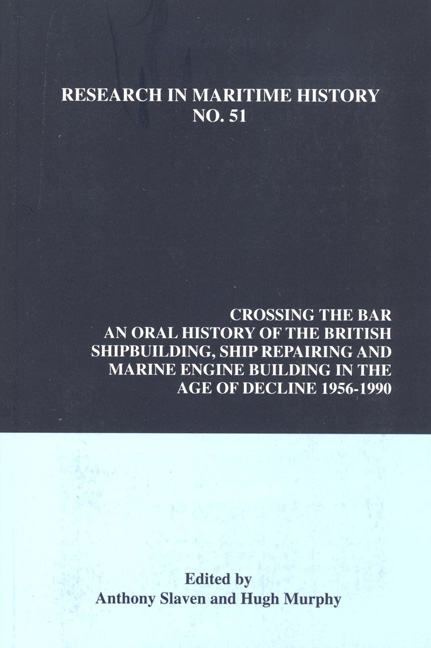 Crossing the Bar
Crossing the Bar Book contents
- Frontmatter
- Contents
- About the Authors
- Dedication
- Preface: A Shipbuilding Libretto
- Introduction
- Interviews
- Lower Clyde
- Upper Clyde
- The Tyne
- 16 G.H.R. Towers, John Redhead and Sons Ltd.
- 17 J.E. Steele, Swan Hunter, British Shipbuilders Plc
- 18 Peter Milne, Swan Hunter, British Shipbuilders Plc
- 19 P.D. Christie, Swan Hunter
- 20 James Jardine, Smith's Dock, Swan Hunter
- 21 Eric Crowdy, Hawthorn Leslie, George Clark NEM, William Doxford Engineers
- 22 M.F. Pyman, Mercantile Dry Dock Co. Ltd., Jarrow
- The Wear
- Barrow-in-Furness
- The South Coast
- The Humber
- Belfast
- British Shipbuilding Industry Officials
- The Trade Unions
- The Civil Servants, Board of Trade, Shipbuilding Enquiry Committee, Shipbuilding Industry Board, Ministry of Technology, Department of Trade and Industry, Department of Industry
- The Politicians
- Interviews British Shipbuilders Plc
- Conclusion
- Select Bibliography
17 - J.E. Steele, Swan Hunter, British Shipbuilders Plc
from The Tyne
- Frontmatter
- Contents
- About the Authors
- Dedication
- Preface: A Shipbuilding Libretto
- Introduction
- Interviews
- Lower Clyde
- Upper Clyde
- The Tyne
- 16 G.H.R. Towers, John Redhead and Sons Ltd.
- 17 J.E. Steele, Swan Hunter, British Shipbuilders Plc
- 18 Peter Milne, Swan Hunter, British Shipbuilders Plc
- 19 P.D. Christie, Swan Hunter
- 20 James Jardine, Smith's Dock, Swan Hunter
- 21 Eric Crowdy, Hawthorn Leslie, George Clark NEM, William Doxford Engineers
- 22 M.F. Pyman, Mercantile Dry Dock Co. Ltd., Jarrow
- The Wear
- Barrow-in-Furness
- The South Coast
- The Humber
- Belfast
- British Shipbuilding Industry Officials
- The Trade Unions
- The Civil Servants, Board of Trade, Shipbuilding Enquiry Committee, Shipbuilding Industry Board, Ministry of Technology, Department of Trade and Industry, Department of Industry
- The Politicians
- Interviews British Shipbuilders Plc
- Conclusion
- Select Bibliography
Summary
In 1950, I was apprenticed as a Ship Draughtsman with Swan Hunter. On completion in 1955, I then spent a year in the shipyard as a journeyman; it involved three months in the Loft, two months in the Plumbers Shop and the Electrical Shop, and then time working with the shipwrights, carpenters, platers and fitters lining off. I then spent two years National Service in the Royal Air Force throughout the Far East, before returning to Swan Hunter in 1958 to work in the Steel Drawing Office. There, I calculated scantlings for steel and aluminium structures, and welding profiles ensuring that they complied with regulatory bodies’ requirements. Around May 1959, I joined the Ship Estimating Office, which I took to like a duck to water. By 1961, I was appointed Section Leader, and two years later, Cost Controller, before in 1964 being placed in charge of all purchasing and material handling. In 1967,1 was appointed Group Purchasing Co-ordinating Manager and Material Controller, and three years later, Purchasing Director. By 1974, I was appointed Deputy Chairman, Chief Executive in 1976, and Chairman and Chief Executive in 1977. Under British Shipbuilders I was a part-time Board Member, and in 1981 was appointed non executive Chairman of Cammell Laird, and overall Managing Director of the Composite Shipbuilding Division. In November 1981, I was appointed a full executive Board Member, and Executive Vice Chairman of British Shipbuilders Offshore Division. A year later I was appointed a Managing Director of British Shipbuilders [one of four]. In 1982, I had resigned from my chief executive position at Swan Hunter, but retained the Chairmanship in a non executive capacity. In May 1983, I was appointed non executive Chairman of Scott Lithgow. When Scott Lithgow was sold, and when Cammell Laird [the two large companies in the ill-fated Offshore Division] integrated into Vickers in 1984, I became Executive Chairman of Vosper Thornycroft, which was subsequently successfully privatised. Thereafter, in January 1987, I was appointed Managing Director of NESL for the last three months before its closure, and subsequently I was made redundant by British Shipbuilders.
Swan Hunter had a lot of orders in the late 1950s. However, the market had changed significantly.
- Type
- Chapter
- Information
- Crossing the BarAn Oral History of the British Shipbuilding, Ship Repairing and Marine Engine-Building Industries in the Age of Decline, 1956-1990, pp. 62 - 73Publisher: Liverpool University PressPrint publication year: 2013
